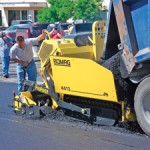Aug
20
Go Where the Heat Energy Is
August 20, 2008 | 3 Comments
The U.S. alone has an estimated 19,000 square miles of asphalt paved roads and parking lots. As essentially everyone can attest, asphalt is a great infrared absorber and being very dense holds a lot of heat thus toasting bare feet with slight sun and barely warm temperatures. Now 19K square miles is a lot of ground, and the optimists in thermal solar claim to need only 15K square miles to power the whole U.S. electric and light transport sector, which gives one a sense of the scale of the matter at hand. After this basic data keep in mind that over 10 to 20 years most every square mile of asphalt needs a recovering.
Worchester Polytechnic Institute as requested by Michael Hulen, president of Novotech Inc. in Acton, Mass, which holds a patent on the concept of using the heat absorbed by pavements, (A patent on a concept?) has conducted a study of asphalt paving as a heat absorber. The idea being to use the existing roads and parking lots as giant thermal solar collectors for electrical power generation and hot water. Tuesday August 19th 11:00 am saw Bao-Liang Chen a PhD candidate at Worchester present the information learned during the research at the International Society for Asphalt Pavements in Zurich, Switzerland.
The research sought to show the best way to construct roads and parking lots to maximize the heat absorbing qualities. Rajib Mallick an associate professor at Worchester directed the research said, “(Asphalt) stays hot and could continue to generate energy after the sun goes down, unlike traditional solar-electric cells. Extracting heat from asphalt could cool it, reducing the urban ‘heat island’ effect. Finally, unlike roof-top solar arrays, which some find unattractive, the solar collectors in roads and parking lots would be invisible.”
The team studied the energy-generating potential of asphalt using computer models and by conducting small and large-scale tests. The tests were conducted on slabs of asphalt with imbedded thermocouples, to measure heat penetration, and copper pipes, to gauge how well that heat could be transferred to flowing water. Hot water flowing from an asphalt energy system could be used “as is” for heating buildings or in industrial processes, or could be passed through a thermoelectric generator to produce electricity.
Two study paths were followed, one in the laboratory where small slabs were exposed to halogen lamps simulating sunlight. Outdoors larger slabs were set up and exposed to more realistic environmental conditions, including direct sunlight and wind. The tests showed that asphalt absorbs a “considerable amount of heat” and that the highest temperatures are found a few centimeters below the surface. This suggests where a heat exchanger would be located to extract the maximum amount of energy. Experimenting with various asphalt compositions, the team found that the addition of highly conductive aggregates, like quartzite, could significantly increase heat absorption, as can the application of a special paint that reduces reflection.
Professor Mallick noted that the team concluded that the key to making asphalt effective at energy collection will be a specifically designed heat exchanger that soaks up the maximum amount of the heat collected by asphalt. Mallick thinks the team’s preliminary results provide a promising proof of concept for what could be a very important source of renewable energy.
I agree. Professor Mallick, let me introduce you to Steven Novak at the Idaho National Laboratory who has a brilliant infrared energy collector that might be just what you’re looking for.
Comments
3 Comments so far



Whatta nice articles…
Recently most people like to save their fuel in whatever way…
By using hydrogen is one of them…
I just find this blog if u like its articles…
http://hidrogen-fuel.blogspot.com/2008/08/understanding-hydrogen-as-alternative.html
[…] Go Where the Heat Energy Is New Energy and Fuel Posted by root 23 hours ago (https://newenergyandfuel.com) Aug 20 2008 a look at how asphalt could be a source of thermal solar energy absorption finally unlike roof top solar arrays which some find unattractive comments 1 comment so far theone on august 20 2008 9 12 am copyright 2007 new energy and fuel powered Discuss | Bury | News | go where the heat energy is new energy and fuel […]
If you are open to having a guest blog poster please reply and let me know. I will provide you with unique content for your blog, thanks.